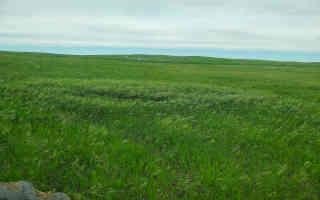By Stan Wise
South Dakota Soil Health Coalition Board member and Colome, SD, producer Van Mansheim doesn’t mince words when it comes to the benefits of bale grazing.
“I hear many producers talk about they’re gonna go do chores for four hours and five hours feeding their cattle. That’s all they do all winter,” he said. “We go out there and roll up a fence every four or five days, and it takes an hour.”
Mansheim runs ManBull Farming with his nephew, Heath Bullington, and together they raise wheat, oats, corn, soybeans, alfalfa, and cover crops, and they custom graze cattle. They use bale grazing – the practice of arranging hay bales on a grid and allowing cattle access to a few bales at a time – to improve their soil, save money, and make their lives easier while feeding cattle in the winter.
Mansheim grazes cattle on corn stalks and cover crops earlier in November and December. In January and February, he lets the cattle graze hay bales. “We set up all the bales before it freezes, usually in later November, early December before the ground freezes, and we take off all the net wrap because we don’t want the cows to have to digest that,” he said. “So that takes roughly about, I would say, eight hours to set up, say, 150 bales – two people. And then every time we move our fence, about an hour.”
Improving soil
There’s a good reason Mansheim grazes the hay bales on the same land where it was grown – his soil. “When you remove the hay or forage, you’re removing all the nutrients. You know, the nitrogen, the phosphorus, the zinc, all the micros,” he said.
That’s why he started bale grazing three years ago. “I could tell our soil was being degraded because we had been haying this ground for 40 years, and we were bringing it into our yard to feed it, but it never got back to the landscape. So, we were actually exporting nutrients from that soil, and the result of that, I was seeing that we were losing hay production.”
The benefits
The bale grazing plan is paying off. “It’s totally improved the water infiltration, and the cattails are virtually gone off that hay ground in three years. The grass has come back,” Mansheim said. “Wherever those residue piles are after they eat them, the infiltration is just phenomenal there, and the biology – it increases the biology. Even though this year we were sort of dry, we have increased hay production on this piece of ground about 30 percent in three years, and we do not fertilize it.”

The grass was taller and thicker in July 2022 in the spot where a hay bale was grazed by cattle the previous winter on Van Mansheim’s operation near Colome, SD. Photo courtesy of Van Mansheim.
This simple, effective soil health practice is making a noticeable difference in Mansheim’s operation.
Click here to see more...